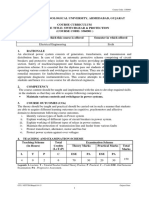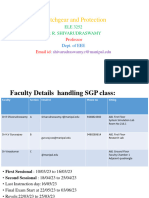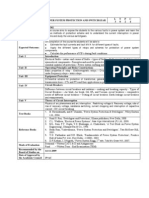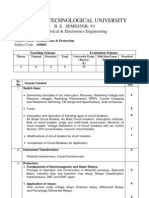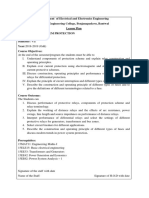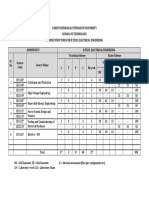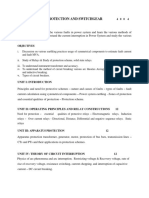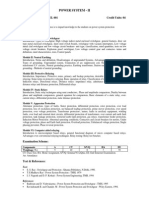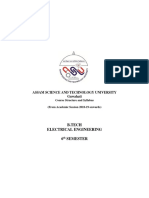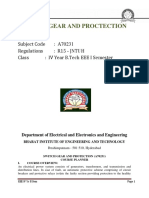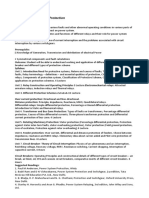0 ratings0% found this document useful (0 votes)
219 views9 pagesSwitchgear and Protection
Uploaded by
036 Ritesh Gaikwad FYEE B1Copyright
© © All Rights Reserved
We take content rights seriously. If you suspect this is your content, claim it here.
Available Formats
Download as PDF or read online on Scribd
0 ratings0% found this document useful (0 votes)
219 views9 pagesSwitchgear and Protection
Uploaded by
036 Ritesh Gaikwad FYEE B1Copyright
© © All Rights Reserved
We take content rights seriously. If you suspect this is your content, claim it here.
Available Formats
Download as PDF or read online on Scribd
You are on page 1/ 9
Course Code: EE4107
Government Polytechnic, Pune
Programme.
"180 OB'— Scheme
Diploma in ET/CE/EE//ME/MT/CM/T/DDGM
Programme code
01/02/03/04/05/06/07/08/15/16/17/18/19/21/22/23/24/26
Name of Course
Switehgear and Protection
Course Code EE4107
Prerequisite course code and
name No
Class Declaration Yes
1, TEACHING AND EXAMINATION SCHEME
Teaching | Total ‘Examination Scheme
Scheme | Credits Theory Practical Total
(in Hours) | (L+T+P) Marks
L iT |P c ESE PA SESE | PA 50
Marks 80 20 35 a
04 | 00 | 02 06 Exam 3 Hrs Hr . _
Duration
Legends: L- lecture, 1
Tutorialteacher guided theory practice, P-practical, C-Credits, ESE-End
semester examination, PA- Progressive Assessments(Test I, Il/Term Work), *- Practical Exam,
$- Oral Exam. #- Online Exam., Each lecture/practical period is of one clock hour.
2. COURSE RATIONALE:
Presentlyelectricalpowersystemisgrowingfastduetoincreasingindustries needs,populati
on. Adiplomapassoutmayhavetoworkinthefieldofgeneration, transmis
iondistributionmain
tenance, testing. Sothestudentmustknowabouttheswitchgear&protection.Itisexpectedthatth
eknowledgeoffacts,concepts, principles and procedural aspects of switchgear and
protection system must be known to the students it will ultimately help the students in
dis
service sectors.
3. COMPETENCY
charging their duties such as technicians, engineer in power house, substation, testing
The aim of this course is to attend following industry identified competency through
various teaching learning experiences:
‘* Maintain switchgear and protection schemes used in electrical power system.
4, COURSE OUTCOMES (COs)
The theory, practical experiences and relevant soft skills associated with this course are
to be taught and implemented, so that the student demonstrates the following industry
oriented COs associated
ith the above mentioned competency:
I: Tdentify various types of faults in electrical power system,
s
> Suggest sui
: Test the performance of different protective relays,
|: Maintain the protection scheme for alternators, transformers and motors and
ible protection scheme for existing fault
transmission lines.
5. SUGGESTED PRACTICALS/ EXERCISES
Course Code: EE4107
: Understand working and maintenance of the lightening arrestors for HV protection
Pr. | Unit Practical Exercises Relevent | Approx.
| Us , a , co Hrs.
No| 3 (Learning Outcomes in Psychomotor Domain) i
required
T_|_2 | To plot operating curent-time characteristics of fuse 12 o
2 | 2 | Visit to L&T Switchgear Training Centre and write 12 04
visit report comprising function, working operation,
testing & maintenance of MCB, ELCB, MCCB and
Contactor.
3 |_2_ | Drawing sheet on eireult breakers-MCB,ELCB, 2 4
SF6CircuitBreakerandVacuumCircuitBreaker.
4 | 2 | Scttingofthermaloverloadrelayandplotthecharacteristie 3 02
softhermaloverloadrelay.
3 [3 | Drawing sheet on Relays—Electromagnetic Relays z oF
(Any Two), Induetion dise type Relay, Thermal Relay,
Buchholz Relay.
© | 4 | Demonstration &Testing of static 4 0
a) over current /under current relay
b)Under voltage & over voltage relay. c) Phase failure
rela
7 | 4 | Drawing sheet on Protection Schemes of Alternator in 7 o
AutoCAD: Biased differential Protection, Restricted
earth fault, Unbalanced load.
3] 5 _| DrawingsheetonProtectionSchemesofTransformerimAu | __2 04
toCAD:-BiaseddifferentialProtection,Earth fault
protection.
3 | 5 | Connect MCB, DOL starter & single phase preventer z 0
in LM. eireuit and check operation for short-cireuit,
overload & single phasing faults
TO] 5 | Visittohighvoltagesubstationd&drawsinglelinediagramo 5 2
{Substation Statefunctiondtechnicalspecificationofequi
pmentsused therein.
TT | 5 | Drawing Sheet on Lightening Anresters-Rod Gap, 3 04
Horn Gap, Expulsion Type, Thyrite Type, metal oxide
type.
Total 32
6. MAJOR EQUIPMENT/ INSTRUMENTS REQUIRED
Course Code: EE4107
S.No. Performance Indicators Weightage in %
a ‘Arrangement of available equipment or model for testing 20
b Setting and operation 15
c. Safety measures 20
d ‘Observations and Recording 15
€. Interpretation of result and Conclusion 15
f Submission of report in time 15
Total 100
‘The major equipment with broad specification mentioned here will usher in uniformity in
conduct of practicals, as well as aid to procure equipment by authorities concerned.
Sr. Equipment Name with Broad Pr. No.
No Specifications
7 HRC fuse, Static relay, DOL 1,69
starter
2 [Visits To Substations, Switchgear Industry
2, 3, 4, 5,7, 8, 10
Course Code: EE4107
7. THEORY COMPONENTS
SECTION-1
Unit Outcomes (UOs)
{in cognitive domain)
Topics and Sub-topies
UNIT-1 Fundamentals of Protection
HRS -05_ Marks-06
Ta Aware of the need and function of
protection system.
1b Differentiate between the normal &
abnormal conditions of power system.
le, List the types of fault &state theit
causes
1d. Determine short circuit current ,
short circuit KVA,
Je. What is the use of current limiting
reactors and draw their arrangements’
T.I Necessity and functions of protective system
1.2 Primary and backup protection.
1.3 Normal & abnormal conditions,
1.4 Type of faults and their causes.
1.5 Short circuit calculations (Numerical on faults
only).
1.6 Use of current limiting reactors & their
arrangements
UNIT-2 Circuit Interrupting Devices
HRS -15_Marks-18
2a, What is fuse? state its different
types and describe construction and
working of HRC fuse.
2b.Enlist the Characteristics of HRC
fuse and its applications.
2c.Explain the necessity of isolators
and write its function.
2d.State the types of Isolators and
describe their working
2e.Describe the process of an Arc
formation.
2f,Understand the various methods of
are extinction and define terms related
with it.
2g. Understand the construction,
working principle and applications of
different types of circuit breakers.
To know the sequence of operation &
interlocking of CBs, isolators &
earthing switch.
2h. Select switchgears as per
application& understand the ratings of
CBs.
2i. To Compare fuse &MCCB
2).To know about HVDC circuit
breakers
2.1 Fuse: basic terminology w.r.t. fuse, types,
Construction and working of HRC fuse.
2.2 Characteristics, selection and applications of HRC
fuse.
2.3 Necessity and functions of Isolators.
2.4 Types of Isolators:-Vertical break, horizontal
break, and pantograph type.
2.5 Are formation process.
2.6 Methods of are extinction — High resistance
‘method and current zero method. Definition: Arc
voltage, Recovery voltage, Resttiking voltage,
RRRV.
2.7. Circuit breakers: - Concept, Classification,
Working principle. Construction, working of
principle, Specification & Applications of
following circuit breakers. L..- Air circuit
breakers (ACB), Miniature circuit breakers,
Moulded case circuit breaker, Earth leakage circuit
breaker .b) H.T— Sulpher Hexa Fluoride (SF6)
circuit breaker and Vacuum circuit breaker.
2.8. Selection of switchgears for particular
applications. Ratings of Cireuit Breaker.
2.9 Comparison of fuse & MCCB
2.10 HVDC CBS: Introduction, problems with are
interruption, HVDC cireuit breaker.
UNIT-3- Protective Relays
HRS -12_ Marks-16
State the need and function of
protective relays system
3b.List the essential qualities of
protective relaying& their importance.
To know the relay terminology.
3c.Classify various types relays
3d.Understand the working principle,
31 Necessity, function& single line diagram of
protective relay system.
3.2 Quality requirements of relay system: selectivity,
speed, sensitivity, reliability, and simplicity,
economy: meaning of the term and its signi
in protective relaying. Basic Relay Terminology:
- Protective relay, relay time, reset time, pick
Course Code: EE4107
Characteristics, and application of
different types of relays.
3e.Understand the operation of over
current relay,
Understand the PSM & TSM and its
effects on characteristics.
up Value, reset value, Auxiliary relay.
3.3. Classification of relays based on terminology used,
principle of operation, times of operation, functions,
protective schemes, characteristics.
3.4 Characteristics, working principle & applications
of following relays: Electromechanical relay(
Hinged armature type only),induetion disc relay,
thermal relay, Static Relays: Introduetion,
advantages & disadvantages of static relays.
Numerical Relays: Introduction, general block
diagram, classifications of numerical relays.
Advantages& disadvantages of numerical
relays. Comparison among the above relays.
3.5. Over current relay: -Time current characteristics &
its classifications. Current setting, plug setting
multiplier (PSM) ,Time setting multiplier
(TMS)Numerical on PSM &TMS. Static over
current relay with all types. Numerical over
current relay ( tC based) with block diagram,
flow chart.
SECTION-2
UNIT4 Protection of Alternator
HRS -06 Marks-08
4a, To know various faults and
Abnormalities of alternator.
4b, Uunderstand the protection
schemes of alternator against different
types of faults.
4c. To know the concept of reverse
power protection
4.1 Abnormalities and faults in alternators.
4.2 Differential protection, biased differential
Protection, Protection against prime mover
failure, field failure and unbalanced load,
restricted earth fault protection, overcurrent,
inter tum fault, over heating protection, over
voltage& motoring action.
4.3 Concept of power protection when it happens.
+ Directional relay: electromagnetic &
numerical (1C based with block diagram
& flow chart only) types
UNIT-05 Protection of Transformer
HRS -06_Marks-08
Sa.ldentify various faults &
abnormalities of transformer
5b.Understand the various protection
schemes of transformer
Sc.Understand the Importance of
Buchholz Relay
3.1 Abnormalities faults in transformers,
5.2. Differential and Biased differential protection,
Limitations of differential protection of
transformer. Simple numerical on differential
protection. Over current, Earth fault, inter turn, over
heating protection.
5.3 Buchholz relay: construction, working principle &
its installation location,
UNIT-06
Protection of Induction Motor
HRS -03_ Marks-04
Ga, Identify various faults &
6.1 Abnormalities and faults in induction motors.,
Course Code: EES107
abnormalities of LM.
6b. Identify various protection
provided for motors.
Observe the behaviour of protective
devices provided for motor.
62 Protections against following faults in motor.
Short circuit & earth fault.
Over load protection.
Single phasing.
UNIT-07 Protection of Busbar &Transmission Line
HRS -07_Marks-08
7a, Identify the faults & abnormalities
of Transmission lines
7b. Understand the working principle
of distance & pilot wire protections,
Je. Understand the Distributionline
Protection scheme& auto reclosing.
74.Understand the Protection scheme
for Bus Bar,
7.1 Abnormalities& Faults on transmission lines,
7.2 Distance Relay: working principle,
electromagnetic type, static and numerical (uC
based with block diagram & flow chart only)
types. Pilot wire protection of transmission
lines: a) working principle of current
circulating & balanced voltage b) carrier
current protection.
7.3 Distribution Tine: Over current protective
scheme for feeders. Auto-reclosing.
7.4 Bus Bar Protection: Faults & Operation of
Differential Protection
UNIT-08 Over Voltage Protection and Neutral Earthing
Ba. State the causes of over voltage
8b.To know the protection from direct
stroke and travelling wave of power
system equipment’s.
8c_List types of lightning arrester
8d.State the need and function of
surge absorbers
8e.Understand the insulation co-
ordination& BIL.
8fUnderstand the importance of
Neutral earthing & its types,
&g.Distinguish between equipment
earthling and neutral earthing
ARS -10 Marks-12
8.1 To lightening its wave shape. Protection of
transmission line and substation from direct
stroke, Protection against traveling wave.
8.2 Types of lighting arresters 1) Rod Gap 2)
Hom Gap 3) Expulsion Type 4) Thyrite
‘Type 5) Metal oxide surge arrester.
8.3 Principle & operation of surge absorbers
Insulation co-ordination and BIL
Introduction & importance Neutral
earthing. Types of neutral earthing-
resistance, reactance, Peterson coil
etc Substation earthing.
8.5 Difference between Equipment earthing
and Neutral earthing,
84
Course Code: EE4107
8 SUGGESTED SPECIFICATION TABLE FORQUESTION PAPER DESIGN-
Unit Unit Tithe Teaching |_ Distribution of Theory Marks
No. Hours [_R U A | Total
Level_| Level | Level | Marks
1__| Fundamentals of Protection 3 o2 | 00 | 04 | 06
2_| Circuit Interrupting Devices 15 “a [2 fo 18
3_| Protective Relays 2 04 | 08 | 04 16
4 _| Protection of Alternator 6 o2 | 04 | 02 | of
3_| Protection of Transformer 6 oe | 4 | 2 | 7
6 _| Protection of Induction Motor 3 2 | 0 | 02 | 04
7 _| Protection of Bus-Bar and 7 o2 | 04 | 02 | 08
Transmission line
8 | Over Voltage Protection and 10 o2 | 04 | 06 2
‘Neutral Farthing
Total cy is [32 [ 30 [| 30
9 SUGGESTED STUDENT ACTIVITIE!
Other than the classroom and laboratory learning, following are the suggested student-related
co-curricular activities which can be undertaken to accelerate the attainment of the various
outcomes in this course: Students should conduct following activities in group and prepare
reports of about 5 pages for each activity, also collect/record physical evidences for their
(student's) portfolio which will be useful for their placement interviews:
Prepare journal based on practical performed in Electrical laboratory. Journal consists of
drawing, observations, required equipment’s, date of performance with teacher signature,
a) Collect specifications of different switchgear equipment used in electrical power
system through market survey/visit and write a technical report.
b) Visit 400/220/132/66/33 kV substation and take the help of sub-station in-charge to
understand various switchgears, protective schemes and occurrences of faulls.
©) Collect data of different protective schemes used for alternator, transformer, bus bar
and transmission lines through intemet/ industrial visit.
4) Write all the safety precautions which are to be taken while working with different
switchgears and protective schemes.
10 SUGGESTED SPECIAL INSTRUCTIONAL STRATEGIES (if any)
These are sample strategies, which the teacher can use to accelerate the attainment of the
various outcomes in this course:
a. Massive open online courses (MOOCs) may be used to teach various topics/sub topics.
b, About 15-20% of the topics/sub-topies which is relatively simpler or descriptive in nature
is to be given to the students for self-directed learning and assess the development of the
COs through classroom presentations (see implementation guideline for details).
c. With respect to item No.8, teachers need to ensure to create opportunities and provisions
for co-curricular activities
Guide student(s) in undertaking micro-projects.
Correlate subtopics with power plant system and equipment's.
Use proper equivalent analogy to explain different concepts.
Use Flash/Animations to explain various components, operation and
‘Teacher should ask the students to go through instruction and Technical manuals
Pemoee
Course Code: EE4107
11, SUGGESTED MICRO-PROJECT!
Only one micto-project is planned to be undertaken by a student that needs to be assigned to
him/her. In the first four semesters, the micro-projects are group-based. However, in the fifth
and sixth semesters, it should be preferably be individually undertaken to build up the skill
and confidence in every student to become problem solver so that s/he contributes to the
projects of the industry. In special situations where groups have to be formed for micro-
projects, the number of students in the group should not exceed three.
The micro-project could be industry application based, internet-based, workshop-
based, laboratory-based or field-based. Each micro-project should encompass two or more
COs which are in fact, an integration of PrOs, UOs and ADOs. Each student will have to
maintain dated work diary consisting of individual contribution in the project work and give a
seminar presentation of it before submission. The total duration of the micro-project should
not be less than 16 (sixteen) student engagement hours during the course. The student ought to
submit micro-project by the end of the semester to develop the industry oriented COs.
A suggestive list of micro-projects is given here. Similar micro-projects could be
added by the concerned faculty( Any one by one batch )
a. Prepare a document for testing of LT swiethgears in detail as per IS,
b. Prepare a document for testing of protective relays in detail as per IS and visit relay
manufacturing industry.
¢. Prepare a document for testing of Lightening Arrestors in detail as per IS.
. Case study of various protection schemes of various equipments used in substation
and generating station.
11 SUGGESTED LEARNING RESOURCES.
itle ‘Author Publication ISBN Number
1 | Switchgearand | Sunil S. Rao Khanna ISBN: 978-93-
protection Publishers, 87394-72-8,
Delhi.
2 |Priciples of power | Mehta VK. Rohit | S. Chand & Co. New | ISBN
systems Mehta Delhi 9788121924962,
3 | Switchgearand [Gupta TB. SK Kataria and ISBN
protection Sons, New Delhi 2014 | 9789350143728
Course Code: EE4107
12. SOFTWARE/LEARNING WEBSITES
www.nptel.ac.in
www.wikipedia.com
www.clectricaltechnology.org
hups://vww.electricaldu.com
13. PO - COMPE!
NCY- CO MAPPING
CO POL PO2 PO3 POd POS POG PO7
i 3 2 i 3 2 1 3
2 2 3 3 2 2 2 3
3 2 2 2 2 1 i 2
4 3 3 2 2 2 i 3
5 2 3 2 2 2 i 2
[e PSO2
1 3 2 1 2
2 3 2 1 2
3 2 2 1 2
4 3 3 2 2
3 3 2 2 2
Siam Sign
Name:
1 Smt USTolangekar Name:Dr. $$ Bharatkar/ShriR.U. Shelke
2. MrS.BKale ewer
‘cons tapes (Head of Department)
Tien Sian
Name:Dr. $.$.Bharatkan'Shri.R-U.Shetke Name: Shri, A. 8. Zanpure
(CDC Incharge)
(Program Head )
(Department of Electrical Engineering)
You might also like
- Guru Nanak Institutions Technical Campus: Mr. S. Rajander ReddyNo ratings yetGuru Nanak Institutions Technical Campus: Mr. S. Rajander Reddy18 pages
- 2EE702 Power System Protection & SwitchgearNo ratings yet2EE702 Power System Protection & Switchgear2 pages
- Syllabus: Electronics Faculty of Engineering Academic School of Electrical Engineering ProfessionalNo ratings yetSyllabus: Electronics Faculty of Engineering Academic School of Electrical Engineering Professional5 pages
- Switch Gear and Protective Devices: Module-I (10 Hours) University Portion (80%) : (8 Hours)No ratings yetSwitch Gear and Protective Devices: Module-I (10 Hours) University Portion (80%) : (8 Hours)2 pages
- ET-335 Transmission, Distribution and Protection of Electrical Power Systems100% (2)ET-335 Transmission, Distribution and Protection of Electrical Power Systems11 pages
- 19EEE401 PSPSG Course Plan 23-24 - FinalNo ratings yet19EEE401 PSPSG Course Plan 23-24 - Final6 pages
- EE454 PowerSystemProtection Course Outline 2016No ratings yetEE454 PowerSystemProtection Course Outline 20164 pages
- IV B.Tech. - I Semester (16Bt70202) Switchgear and ProtectionNo ratings yetIV B.Tech. - I Semester (16Bt70202) Switchgear and Protection2 pages
- 1.EEE304 Power System Protection TechniquesNo ratings yet1.EEE304 Power System Protection Techniques2 pages
- Detailed Syllabus Contents (6th Sem EE)No ratings yetDetailed Syllabus Contents (6th Sem EE)31 pages
- Switch Gear and Proctection: Subject Code: A70231 Regulations: R15 - Jntuh Class: IV Year B.Tech EEE I SemesterNo ratings yetSwitch Gear and Proctection: Subject Code: A70231 Regulations: R15 - Jntuh Class: IV Year B.Tech EEE I Semester21 pages



